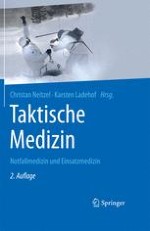Zusammenfassung
In taktischen Lagen muss die Dringlichkeit der Versorgung der Patienten gegen die Gefährdung der Helfer wie auch des Patienten abgewogen werden. Die dargestellten Leitlinien zeigen einen Algorithmus für die Prioritätensetzung in unterschiedlichen Phasen. In der Phase »Care under Fire« reduzieren sich die zu ergreifenden Maßnahmen auf die Rettung aus dem Gefahrenbereich und die Kontrolle kritischer Extremitätenblutungen. Besteht keine unmittelbare Gefahr mehr, erfolgt in der Phase »Tactical Field Care« die strukturierte Untersuchung und Therapie. Dabei wird nach einem Schema vorgegangen, das die am schnellsten lebensbedrohlichen Probleme zuerst erkennt und löst. Die Phase »Tactical Evacuation Care« beschreibt die Maßnahmen rund um den Transport von Patienten und die Phase »Prolonged Field Care« zeigt auf, was bei einer (z. B. aufgrund verzögerter Evakuierung) verlängerten Behandlungsdauer an pflegerischen und intensivmedizinischen Aspekten zu beachten ist.
